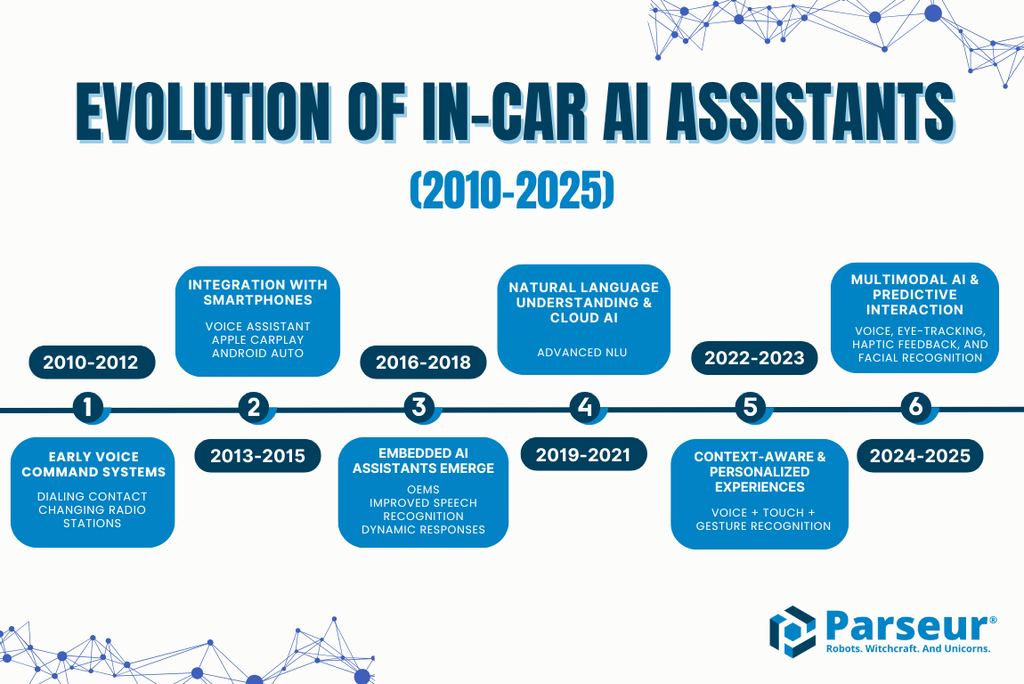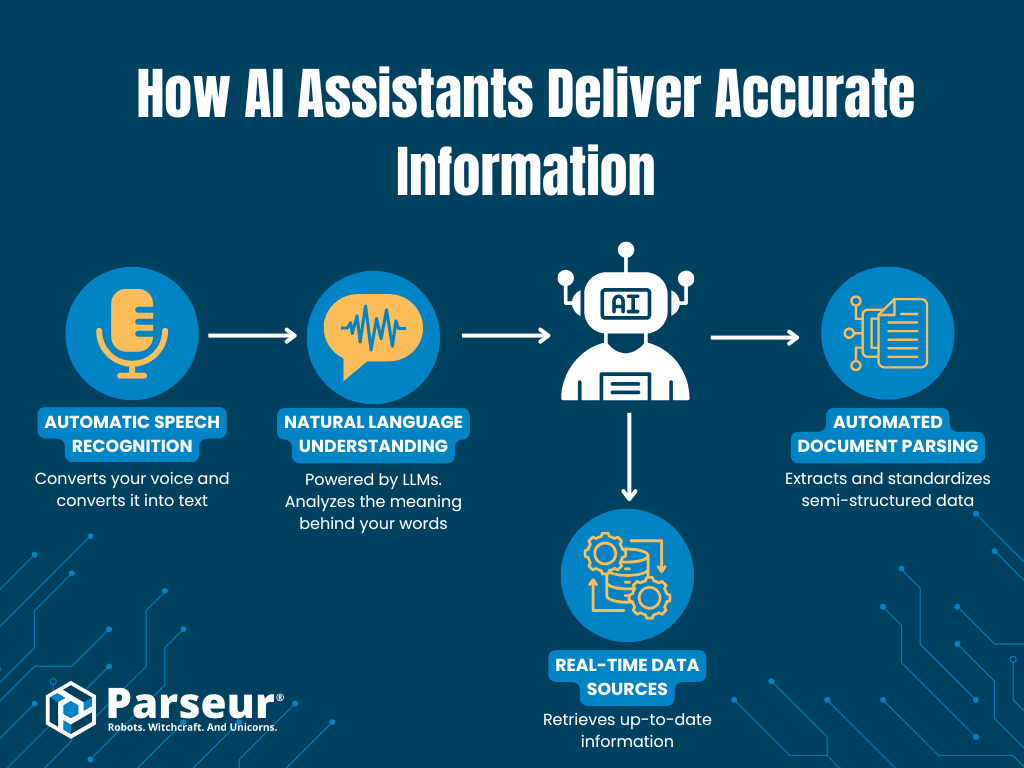Key Takeaways
- LLM-powered assistants are turning cars into intelligent, real-time copilots.
- Voice assistants now handle EV navigation, safety alerts, and personalized tips.
- Clean, structured data is essential for fast, accurate AI responses.
- Tools like Parseur help transform messy, inconsistent data into clean, assistant-ready formats.
Meet Your Car’s New AI Assistant
“Hey, Car, find me the nearest charging station.” Within seconds, the assistant responds: “There’s a 150kW charger 1.2 miles away, today's price is $0.39/kWh, and two slots are available.” This isn’t science fiction; it’s now a real-world in-car experience powered by cutting-edge AI voice assistants.
Thanks to large language models (LLMs) like Gemini and GPT-4, the once-clunky voice interface in cars has evolved into a real-time, intelligent co-pilot. These systems can understand natural speech, process contextual data, and deliver actionable answers on the go, whether you’re navigating, checking vehicle diagnostics, or searching for an EV charger.
This leap in capability is fueling rapid market expansion. According to The Business Research Company, the in-car voice assistant market was valued at USD 3.27 billion in 2026 and is projected to grow to USD 5.49 billion by 2029, at a compound annual growth rate (CAGR) of 13.9%. Behind this momentum lies the rising adoption of connected car technologies, AI advancements, and growing demand for smarter, more personalized, and real-time voice interactions on the road.
Want to explore these trends further? Read our guide: AI-Powered Document Processing in the Automotive Industry to see how structured data is transforming connected mobility.
From Basic Commands To Conversational Intelligence
Not long ago, in-car voice assistants were limited to simple, rigid commands like “Call John” or “Play radio.” They often misunderstood accents, couldn’t handle follow-up questions, and offered minimal functionality beyond a predefined set of voice triggers. Frustration was common, and usage rates remained low as drivers found them more trouble than help.

Modern AI-powered voice assistants driven by advanced Large Language Models (LLMs) like Gemini and GPT-4 represent a complete paradigm shift. Instead of forcing users to memorize commands, these systems understand natural, conversational language. You can say, “Hey, I’m low on battery, is there a fast charger nearby that’s still open?” and the assistant will check availability, pricing, and operating hours in real time, then recommend the best route with minimal input from the driver.
Modern AI voice assistants in automotive settings can handle far more than navigation. Compare that to older systems, where “Find Italian food” might yield a list of random restaurants with no filtering or map integration. The leap from static commands to dynamic conversation isn’t just a technical upgrade; it’s a shift in how drivers interact with their vehicles.
These assistants aren’t just listening anymore. They’re understanding, responding, and actively enhancing the journey. According to SoundHound, 76% of U.S. drivers surveyed say they would be likely to use voice generative AI capabilities in their vehicle if available, a 52% increase from the previous year. This represents strong consumer demand for more advanced, conversational assistants that go beyond simple commands.
Enhancing The Driving Experience With AI
Modern LLM-powered in-car AI assistants do more than just follow commands; they anticipate needs, deliver personalized assistance, and make driving safer and more comfortable. Here are four real-world ways these intelligent systems are transforming the driver experience:
1. Real-time EV charging station navigation
Instead of scrolling through apps or tapping touchscreen menus, drivers can simply ask, “Hey Car, find me a fast charger near my destination.” The assistant instantly checks real-time station availability, charging speed, current pricing, and traffic conditions, offering turn-by-turn navigation to the best option. For EV drivers, this seamless access reduces anxiety and saves precious time.
2. Context-aware navigation
Modern AI voice assistants in automotive settings go beyond GPS directions. If a sudden downpour or traffic accident occurs along your route, the assistant can reroute proactively, explain why, and even suggest a safer or faster alternative. It understands not just where you’re going, but what’s happening around you.
3. Personalized recommendations
Driving through a new city? Your car knows your preferences, like vegetarian dining, dog-friendly stops, or low-cost parking, and offers tailored suggestions. It’s like having a local guide riding shotgun, always ready with the right answer.
4. Safety and comfort
By handling hands-free tasks like replying to texts or emails, and alerting you to road hazards conversationally (“Watch out, sharp turn ahead in 500 meters”), AI assistants help reduce distractions and cognitive load. This leads to safer, more relaxed driving, especially on long trips or in complex environments.
Together, these innovations are redefining the in-car experience, making it more intelligent, human, and stress-free.
Behind The Scenes: How AI Assistants Deliver Accurate Information
Ever wondered how your car’s voice assistant can instantly respond to complex requests like, “Find the nearest available fast charger under $0.40 per kWh”? Behind that quick reply lies a sophisticated orchestration of AI technologies working in harmony. Top-tier voice assistants aim for end‑to‑end latency of under 500 ms, with some systems on edge devices achieving as low as <250 ms according to Deepgram. For example, Deepgram’s API processes speech in under 250 ms, enabling seamless, real‑time interactions in noise‑challenged environments like vehicles,
It all starts with Automatic Speech Recognition (ASR), which captures your voice and converts it into text. Then, Natural Language Understanding (NLU), powered by Large Language Models (LLMs) like GPT-4 or Gemini, analyzes the meaning behind your words. These systems can interpret nuanced intent, such as prioritizing charger speed, price, or proximity, even if you didn’t say it explicitly.

Once the assistant understands the driver's intent, it taps into real-time data sources such as structured APIs, JSON feeds, or internal documents from charging station providers to retrieve up-to-date information on availability, pricing, and charger types.
Since this data often comes in semi-structured formats like PDFs, emails, or CSVs, automated document parsing tools play a critical role in extracting and standardizing it for immediate use. By combining natural speech processing, contextual understanding, and real-time data integration, modern in-car AI assistants can translate a simple voice request into accurate, actionable guidance within seconds.
Leading In-Car AI Assistants in 2026
Major automakers are now embedding generative AI into their in-car systems to support conversational, real-time interactions that enhance safety and convenience. Systems like Mercedes-Benz’s MBUX, Tesla’s Grok, Lucid’s SoundHound-powered assistant, and Volkswagen’s IDA (enhanced with ChatGPT and Cerence) support natural, conversational queries and real-time decision-making.
These assistants go far beyond static commands, handling complex requests like charging station availability, navigation updates, and contextual infotainment. To perform reliably, they rely on accurate, structured data delivered in real time, often pulled from diverse sources such as APIs, PDFs, or CSVs. Ensuring that this data is clean and accessible is essential to keeping these advanced assistants responsive and helpful.
| Brand/Assistant | AI Model | Focus Areas | Notable Features |
|---|---|---|---|
| Mercedes‑Benz MBUX | ChatGPT / Gemini | Conversation, navigation, search | Personalized responses, AR navigation overlay |
| Tesla Grok | xAI Grok (Grok 4) | General queries, real-time answers | Deep LLM integration in the FSD system. |
| Lucid Assistant | SoundHound Chat AI | Multilingual support, onboard knowledge | Offline capability, door-to-car functionality |
| VW IDA | Cerence + ChatGPT | Voice interaction, route guidance | Model-wide rollout with AI-enhanced per-model behavior |
| SoundHound Assistants | Proprietary LLMs + generative | OEM-specific waveforms, brand personality | Multi-turn dialogue, industry-specific features |
Practical Challenges In Building Effective In-Car AI Assistants
As impressive as in-car AI assistants may seem, developing them involves tackling several real-world challenges, especially when they're powered by Large Language Models (LLMs):
Real-time data accuracy:
A key challenge for in-car AI assistants is keeping up with how quickly information changes on the road, especially when it comes to finding available EV charging stations. Charger availability can shift by the minute as cars come and go, and if the assistant provides outdated info, it can cause frustration, delays, or worse, leave a driver without a place to charge. For drivers who depend on accurate, timely updates, even small gaps in data can undermine trust in the system.
Latency management:
Voice assistants must respond almost instantly for natural, safe interactions. However, processing queries and retrieving data across APIs and systems can introduce delays. A recent study by MoldStud found that 70% of users expect voice assistant commands to be executed in less than 1 second, highlighting the critical need for low-latency responses in automotive environments.
Data inconsistency:
Charging networks, map services, and local infrastructure providers all use different formats, such as emails, PDFs, APIs, and CSVs, making it difficult to standardize information for the assistant to consume.
Automatically parsing and structuring data from varied and messy formats is essential for feeding consistent, clean information into AI assistants. This dramatically boosts the reliability, speed, and responsiveness of in-car experiences, allowing drivers to confidently rely on their AI copilots.
What The Future Holds: The Next Generation Of In-Car AI Assistants
The next wave of in-car AI assistants will go far beyond voice. We’re entering the era of multimodal assistants where systems combine voice, camera vision, and contextual data to deliver a truly intelligent driving experience. Imagine your assistant not only responding to “Find me a parking spot,” but also scanning the surroundings to visually identify one, or reading traffic signs and adjusting routes accordingly.
Even more transformative are predictive, proactive AI copilots. These systems will anticipate your needs before you speak, suggesting a charging stop based on your remaining range and current traffic, or recommending a break if it detects signs of fatigue through voice tone or driving behavior.
Integration with smart-city infrastructure will further enhance this ecosystem. Future AI assistants may reserve EV charging spots ahead of arrival, adjust routes based on real-time traffic light coordination, or manage toll payments autonomously.
The growing demand for these capabilities is reflected in industry growth. According to Global Market Insights, the global automotive voice recognition market was valued at $3.7 billion in 2024 and is projected to grow at a CAGR of 10.6% between 2026 and 2034.
One critical ingredient powers all this innovation: structured, real-time data. Automated data parsing supports this by enabling reliable, real-time data extraction, helping developers and automakers standardize inputs from documents, feeds, and systems. It’s the unseen engine behind the seamless intelligence that drivers will soon expect from their cars.
Next Steps In Bringing Future-Ready AI To Your Vehicles
In-car AI voice assistants are no longer a futuristic luxury; they're rapidly becoming essential to delivering safer, smarter, and more personalized driving experiences. From real-time EV charging station navigation to hands-free communication and proactive route suggestions, LLM-powered systems are redefining what drivers expect from their vehicles, reflecting the rapid adoption of voice-controlled features for safer, more connected, and personalized experiences.
A report from Data Insights shows that the automotive artificial intelligence (AI) chatbot market is projected to grow at a compound annual growth rate (CAGR) of 25% from 2026 to 2033, reaching an estimated $25 billion by 2033. As the automotive industry races toward more connected, intelligent ecosystems, this is the moment for automakers, mobility tech providers, and developers to integrate next-generation assistants. Doing so not only enhances the user experience but also creates a long-term competitive advantage.
Want to explore how real-time data and automation are driving this shift? Check out our AI-Powered Document Processing in the Automotive Industry to see how structured data is fueling the next generation of in-car AI.
Ready to upgrade your vehicle’s AI experience?
Explore how Parseur helps simplify real-time data extraction across sources, making your in-car assistant faster, smarter, and more reliable.
Frequently Asked Questions
Here are all your questions answeres about In-Car AI Assistants.
-
What makes modern in-car AI assistants different from older voice systems?
-
Traditional voice assistants relied on fixed commands and struggled with natural conversation. Modern AI assistants powered by LLMs like GPT-4 and Gemini understand context, follow up on questions, and deliver real-time, personalized guidance, making them far more useful and human-like.
-
Why is real-time data so important for in-car AI systems?
-
In fast-changing environments like EV charging or traffic navigation, outdated information can lead to delays or frustration. Real-time, structured data ensures the assistant provides accurate, actionable answers, exactly when drivers need them.
-
What challenges do developers face when building AI voice assistants for cars?
-
Some of the biggest hurdles include processing messy data formats (like PDFs, emails, or CSVs), minimizing latency, and ensuring consistent data from multiple third-party sources. These issues can impact responsiveness and user trust.
-
How does Parseur help improve in-car voice assistants?
-
Parseur automates the extraction of structured data from messy documents and feeds, turning emails, invoices, or charging network updates into clean, ready-to-use formats. This ensures AI systems receive the timely, accurate information they need to respond quickly and reliably.
Last updated on




